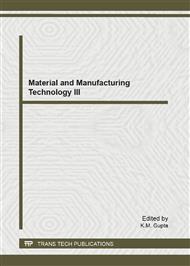[1]
Directive 2002/95/EC of the European Parliament and of the Council. On the restriction of the use of certain hazardous substances in electrical and electronic equipment [J]. Official Journal of the European Union, 2003, 23: 19-37.
Google Scholar
[2]
D.Q. Yu, C.M.L. Wu, L. Wang, The electrochemical corrosion behavior of Sn9Zn and Sn-8Zn-3Bi lead-free solder alloys in NaCl solution, in: 16th International Corrosion Conference, Beijing, China, 2005, 19-24.
DOI: 10.4028/www.scientific.net/amr.1095.95
Google Scholar
[3]
M. Abtew, G. Selvaduray, Lead-free solders in microelectronics, Materials Science and Engineering, 2000, 27: 95-141.
DOI: 10.1016/s0927-796x(00)00010-3
Google Scholar
[4]
M. N. Islam, Y. C. Chan, A. Sharif, et al. Effect of 9 wt. % In addition to Sn3. 5Ag0. 5Cu solder on the interfacial reaction with the Au/NiP metallization on Cu pads, Journal of Alloys and Compounds, 2005, 396: 217-223.
DOI: 10.1016/j.jallcom.2005.01.001
Google Scholar
[5]
J.S. Hwang, Z. Guo, H. Koenigsmann, Surf. Mount Technol., 2001, 13 (2): 7–13.
Google Scholar
[6]
T. C. Chang, J. W. Wang, M. C. Wang, et al. Solderability of Sn-9Zn-0. 5Ag-1In lead-free solder on Cu substrate, Part 1: Thermal properties, microstructure, corrosion and oxidation resistance. Journal of Alloys and Compounds, 2006, 422: 239-243.
DOI: 10.1016/j.jallcom.2005.09.094
Google Scholar
[7]
L. Hua, X. P. Guo, J. K. Yang, Effects of Bi doping on electrochemical corrosion and dendrite growth suppression of lead-free Sn-3. 0Ag-0. 5Cu solder, The Chinese Journal of Nonferrous Metals, 2012, 22(1): 1-7.
Google Scholar
[8]
F. J. Wang, X. Ma, Y. Y. Qian, Improvement of microstructure and interface structure of eutectic Sn-0. 7Cu solder with small amount of Zn addition, Scripta Materialia, 2005, 53: 699-702.
DOI: 10.1016/j.scriptamat.2005.05.013
Google Scholar
[9]
H. Oulfajrite, A. Sabbar, M. Boulghallat, A. Jouaiti, R. Lbibb, A. Zrineh, Electrochemical behavior of a new solder materials (Sn-In-Ag), Materials Letters, 2003, 57: 4368-4371.
DOI: 10.1016/s0167-577x(03)00326-4
Google Scholar
[10]
R. Mahmudi, A. R. Geranmayeh, M. Salehi, H. Pirayesh, Impression creep of the rare-earth doped Sn-2%Bi lead-free solder alloy, Journal of Materials Science: Materials in Electronics, 2010, 21(3): 262-269.
DOI: 10.1007/s10854-009-9903-6
Google Scholar
[11]
L. Hua, H. N. Hou, H. Q. Zhang, T. Wu, Y. H. Deng, Effects of Zn, Ge doping on electrochemical migration, oxidation characteristics and corrosion behavior of lead-free Sn-3. 0Ag-0. 5Cu solder for electronic packaging, Proceedings of the 2010 11th International Conference on Electronic Packaging Technology & High Density Packaging (ICEPT-HDP 2010), 2010: 1151-1157.
DOI: 10.1109/icept.2010.5582749
Google Scholar
[12]
D. Z. Li, P. C. Paul, C. Q. Liu, Corrosion charaterization of tin-lead and lead free solders in 3. 5wt. % NaCl solution, Corrosion Science, 2008, 50: 995-1004.
DOI: 10.1016/j.corsci.2007.11.025
Google Scholar
[13]
G. Saad, A. Fawzy, E. Shawky, Effect of Ag addition on the creep characteristics of Sn-8. 8wt. %Zn solder alloy, Journal of Alloys and Compounds, 2009, 479: 844-850.
DOI: 10.1016/j.jallcom.2009.01.069
Google Scholar
[14]
A. A. EI-Daly, A. E. Hammad, Development of high strength Sn-0. 7Cu solders with the addition of small amount of Ag and In, Journal of Alloys and Compounds, 2011, 509, 8554-8560.
DOI: 10.1016/j.jallcom.2011.05.119
Google Scholar
[15]
L. Hua, M. W. Su, W. J. Zhang, Q. L. Hu, Electrochemical migration and rapid whisker growth of Zn and Bi dopings in Sn-3. 0Ag-0. 5Cu solder in 3wt. % NaCl solution, Advanced materials Research, 2011, 239-242: 1751-1760.
DOI: 10.4028/www.scientific.net/amr.239-242.1751
Google Scholar
[16]
A. Ahmido, A. Sabbar, H. Zouihri, et al. Effect of bismuth and silver on the corrosion behaviour of Sn-9Zn alloy in NaCl 3 wt. % solution, Materials Science and Engineering B, 2011, 176: 1032-1036.
DOI: 10.1016/j.mseb.2011.05.034
Google Scholar


